|
December 4th is celebrated as the Feast of St. Barbara in Poland. She is the patron saint of stone, coal, metal and salt miners miners throughout the country. Celebration of Feast of St. Barbara in Wieliczka salt mine 2023. In the Wieliczka salt mine in Kraków, listed by UNESCO (United Nations Educational, Scientific and Cultural Organization) as one of the most remarkable sites in the world, her feast day is celebrated by miners with a mass in the chapel of St. Kinga. Prayers to her begin with "St. Barbara, patroness of the brotherhood of miners, protect us on the ground and under the ground...". Her image can frequently be found near mines along the Carpathians where the extraction of metals and ore has been a tradition since the 15th century. Not as well known is the fact that St. Barbara is patron saint to fishermen and anyone who worked on rivers or plied the sea. In olden times in Mazowsze her image could be found on the masthead of boats and barges and no sailor or deckhand would leave land without her image on their person. During the reign of Augustus the II in the 17th century, in the church of the Blessed Virgin Mary in Warsaw, fishermen and their entire families attended masses in the morning and evening of her feast day and brought fish that was to be distributed to the poor. Because of her close association with water her image also appears in numerous churches and roadside chapels and shrines in the Pomorze (Pomerania) district along the Baltic Sea coast. 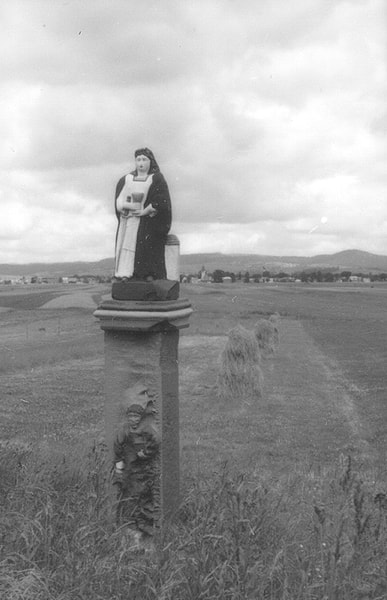 In church statues, roadside shrines and paintings, St. Barbara may be depicted in a variety of ways; carrying the sacramental cup and host; a tower, in which she was confined before her beheading; a sword, the instrument of her death and holding a green palm. This roadside shrine, established at the turn of the 19th and 20th centuries and located on the road from Czarnej Dunajec to Nowy Targ, depicts St. Barbara holding a chalice and host, which according to legend an angel was to have brought her communion while confined to the tower; a sword that was used to behead her for refusing to deny her faith; and the tower of her imprisonment behind her. Excerpted from Spirit of Place: The Roadside Shrines of Poland. Hippocrene Books, Inc. Photo of miners at Wieliczka from https://www.kopalniawieliczka.eu/barborka-2023/
0 Comments
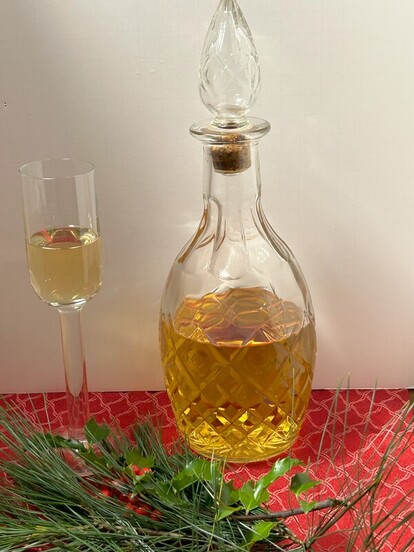 Not to confused with the barley soup that uses the same name, krupnik was (and still is) a popular alcoholic drink prepared in homes throughout Poland and Lithuania from the time of the Middle Ages. Vodka began to appear in Poland in the 16th century and commonly available by the 1800s. Sugar, however was a more rare commodity - too expensive to be used as a sweetener- people reached for the more readily available honey that often came from their own beehives to make their liqueurs. Krupnik is made from easily available ingredients but there are as many recipes for krupnik as there are individuals who like to make their own spirits. Some may have an old family recipe or preferences for a particular spice or ingredient such as cardamom or anise or seek a more intense ginger flavor. Author photo. The two mandatory ingredients to make krupnik are (1) vodka which comes in a range of proofs such as 80 or 100 or the very potent spirytus at 192 proof; and (2) honey. The type of honey (buckwheat, wild flower, orange blossom, linden flower, etc.) will make a difference in shaping the color, taste and final aroma of the drink so that, too, is personal preference. 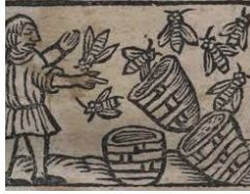 The beautiful amber color, the final sweet and aromatic aroma with hints of cinnamon, ginger and cloves is worth making in autumn or winter or for the Easter holidays. It can be served in small glasses at room temperature or, for those cold nights, heated in a pot over low heat and served in tiny cups. It also goes great with chocolate! Woodcut of beehive from 16th c. Polish text. Here is a recipe from Polish Country Kitchen Cookbook p.201 Smacznego! (May it be tasty!)  Meeting the legacy left by St. Pope John Paul II amidst ancient historical ruins, cathedrals and streets of England, Ireland and Scotland. England October 2, 2023 I would have missed it altogether. I was looking at the inscription on the stone floor marking the place of Thomas Becket’s martyrdom in Canterbury Cathedral in 1170 when the tour guide suddenly spoke about Pope John Paul II and pointed out the memorial plaque on the side wall commemorating his visit to the chapel. On May 29, 1982, two major church leaders – the Archbishop of Canterbury, Robert Runcie, the leader of the world-wide Church of England, and Pope John Paul II, leader of world-wide Roman Catholic Church knelt together in silent prayer in the spot where Thomas Becket, also known as Saint Thomas of Canterbury, was murdered when he opposed his king and placed the rights of the church before any government interests. The Pope’s visit to the United Kingdom, which had begun the day before, made history. It was the first time a reigning pope had ever visited the country. From left: the newer altar (1986) at Canterbury (author photo); Pope John Paul and Robert Runcie at prayer (Canterbury Cathedral photo); the commemorative plaque on side wall of the chapel (author photo). Ireland October 8, 2023 Clonmacnois was a stop on our way to Dublin. Located at the geographical center of Ireland, Clonmacnois was founded by St Ciarán and his small band of monks. It became an outstanding spiritual center for one thousand years where people sought silence, renewal and a sense of the sacred. There really was something otherworldly about the ruins and the location. And again, it was the tour guide who startled me when he said Pope John Paul II visited the ancient ruins of Clonmacnois in 1979 and pointed to the modern covered structure where he said mass during his that visit. Pope John Paul II became the first pope to ever visit Ireland when he had arrived in Dublin the day before for a three-day visit . From left: Ruins at Clonmacnois (author photo);Pope John Paul II at Clonmacnois in 1982 (Clonmacnois photo); covered building where Pope John Paul II celebrated mass during his visit (author photo). Scotland, October 11, 2023 In Edinburgh, Scotland our hotel was on Princess Street, almost directly across from the magnificent Balmoral Hotel, once a great railway hotel built in 1902. It is a main thoroughfare and highly traveled. I discover that it was on this very same street that His Holiness traveled in his pope mobile during his visit to Edinburgh in 1982. Some 40.000 young people from all over Scotland came to greet him, singing 'You'll Never Walk Alone” referring perhaps to the pope’s constant reminder in his many addresses and homilies “that you are never alone, Christ is with you on your journey every day of your lives.” He became the patron saint of World Youth Day. Photos from Edinburgh Herald News 2022 in a retrospective of his visit 40 years earlier. He was: the first non-Italian since 1523 to become Pope; the longest serving Pope in history; a Pope that circled the globe fulfilling a mission to be present to all, praying with Anglicans, Jews and Catholics alike; a man so many agree to be the most consequential pontiff of modern times. 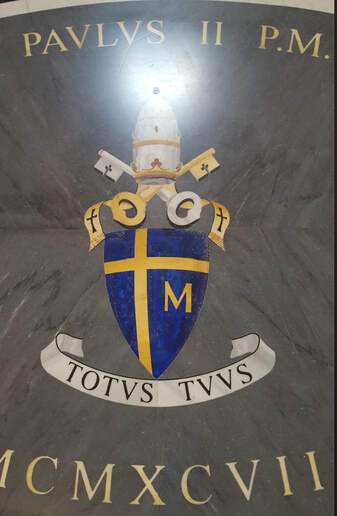 Something I also didn’t know. As a result of Pope John Paul II’s special devotion to the Blessed Virgin Mary, he had the following Latin motto engraved on his coat of arms: “Totus Tuus,” meaning, "I am totally yours." It was taken from a book written much earlier by St. Louis de Montfort’s (1673 – 1716) titled True Devotion to Mary. The full line reads: “Totus tuus ego sum et omnia mea tua sunt… I am totally yours and all that I have is yours.” He entrusted himself and his purpose completely to the Blessed Virgin Mary. The small, unexpected encounters during this trip; to see and be in a few places of what I know to be a very, very tiny portion of the travels and sphere of influence of St. Pope John Paul II, felt extraordinary and very personal. (Photo left from St.Peter's Basilica) Sources: https://www.heraldscotland.com/news/20185760.herald-decades-popes-visit-scotland-1982-changed-nation/ https://www.armagharchdiocese.org/19-sep-national-commemoration-of-pope-john-paul-iis-visit-to-ireland-clonmacnois/ https://www.vatican.va/content/john-paul-ii/en/speeches/1979/september/documents/hf_jp-ii_spe_19790930_irlanda-clonmacnois.html Photo credit on Princess Street: https://www.edinburghnews.scotsman.com/heritage-and-retro/heritage/the-pope-in-edinburgh-40-years-on-here-are-27-amazing-pictures-of-pope-john-paul-iis-visit-to-the-capital Today, September 10, 2023, in Markowa, Poland, the beatification of the Ulma Family by the Catholic Church will take place, the first time that a whole family has been raised to the altars at one time, including an unborn child. Having read of them during my research of Poland and World War II, I made the pilgrimage to their grave site on September 6, 2014 to pray and to give honor to a family that died at the hands of Nazi's. Poland during World War II was a country full of tremendous suffering, death and destruction. It was a country occupied by the Nazi's who did everything they could to destroy a nation and its people. For the people living through those terrible years it was a time of trials and tests, of difficult choices and moral dilemmas. The Jewish people were persecuted, hunted down, sent to concentration camps and murdered by the millions. Any Pole who made attempts to assist or harbored them were put to death. Among those who assisted Jews was the Ulma family. In 2004, on the 60th anniversary of their death, the community of Markowa unveiled a monument in memory of the Ulma family. In saving the life of others they offered their own Józef Ulma, his wife Wiktoria and their children: Stasia, Basia, Wladziu, Francuś, Antoś, Marysia, and unborn child. Hiding eight of their fellow Jewish brethren in their attic during World War II, they died with them in Markowa on March 24, 1944 at the hands of the German Police. May their offering be a call to respect and love every human being. They were sons and daughters of this land In the early morning hours of March 24, 1944, the German military police reached the house of Józef Ulma. Local Poles were made to bear witness to what happens "to those who hide Jews.” The eyewitnesses stated that the Jews were shot first - in the back of the head. Then they shot Józef and his wife Wiktoria, who was nine months pregnant. The children were screaming. When the question came up about what to do with the children, they shot them as well. Their ages ranged from 8 years old to 1½. Within minutes, 17 lives were lost. The village major was instructed to bury the victims with the help of the other witnesses. The event was never forgotten by the inhabitants of Markowa. In postwar Poland, Poles who saved Jews were often the object of repressive measures by the communists. Subsequently, the subject was not discussed. It is only under a free and independent Poland that Polish historians were able to compile lists and gather written statements and documents from people who kept quiet about their experiences of attempts to help and save Jews during the war. 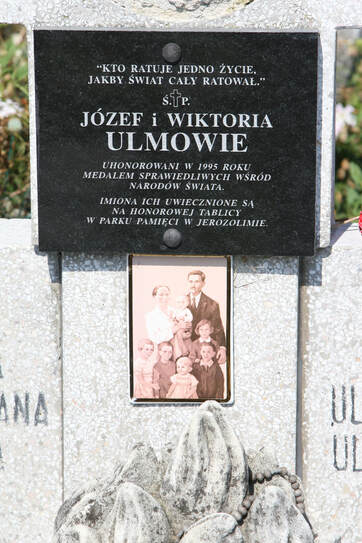 The plaque states that on November 1995, the heroism of Józef and Wiktoria Ulma was recognized by the Jewish community when the Ulma’s were posthumously awarded the medal of Righteous Among Nations by Yad Vashem. The process of beatification of the Ulma family was begun by the Catholic Church in 2003. As I join the rest of the Catholic world in this recognition of the ultimate sacrifice of the Ulma’s, l recall the words on their monument: May their offering be a call to respect and love every human being. Wieczny odpoczynek racz im dać, Panie, a światłość wiekuista niechaj im świeci. Eternal rest give unto them O Lord and let the perpetual light shine upon them. They're not as prevalent now as they used to be as in the late 50’s and early 60’s. Many have gone the same way as hula hoops and Queen For a Day but there was a time when all the churches held a big church festival, a Lawn Fete, to raise money to pay off the church mortgage, a new roof or outstanding bills. Ours had one, too, every July and it was a huge event held on the church grounds that encompassed practically a whole city block. The men in the Holy Name Society ran the beer tent, sold raffle tickets for baskets of cheer, organized the bingo game, the ring toss and other games of chance. Another hired the Ferris wheel and rides like the Bullet and Swings as well as a merry-go-round for the younger kids. There was popcorn, cotton candy machine and candy apples, and on Sunday the Mother’s Club was in charge of the Ten Cent Supper. We kids were there when the carnival people showed up to drive in the stakes and haul up the tents. We watched Koch's, our local brewery, roll kegs down the ramp into the beer tent. We picked out the teddy bears we wanted to win, looked for lost money and were there early Saturday morning as a steady parade of women from the Mother’s Club began making their way to the back of the church to the steps that led down to the church kitchen. Some arrived on foot in their slippers wearing sleeveless housedresses, their hair in pin curls, dishtowels slung across a shoulder, carrying cakes and kettles from their homes just across the street. Others came by car, emptying trunks filled with potatoes and celery and bags of groceries in preparation for the Ten Cent Supper. If you think, as I did the first time I heard it, that you could buy a whole supper for ten cents, it wasn't that way at all. The way it worked was that each item purchased was priced at ten cents. One pig-in-a-blanket - ten cents. One scoop of mashed potatoes - ten cents. One dinner roll - ten cents. A square of pineapple upside down cake - ten cents. A cup of coffee was ten cents, too. It seems a pittance now but back then it was still something. If the weather held, the supper was always held outside in the back of the church by the door that led down to the basement where a large kitchen accommodated dozens of women checking ovens, stirring pots and washing dishes. The food line was set out on tables alongside the sidewalk that eventually led to the basement door. That way, it wasn't far to go when toting heavy pots up the basement stairs. There was also a huge elm tree back there, one of a long line that ran along the length of the church. Its leafy branches spread out far enough to shade the food line and the tables on the long driveway where supper-goers sat down and ate. Starting at about 4pm, garbed in Better Dresses, but sensibly covered with aprons fit for "company," and hair nicely curled, four or five of the mothers stood behind the food tables, ladling out mashed potatoes, gołąbki (the pig-in-a-blanket made of rice and meat wrapped in a cabbage leaf), meatballs or sausage, trying to strike a balance between generous and not overly so. No one wanted the word to circulate that the portions were "cheesy." Faces flushed and hair drooping from their exertions, the steaming food and the hot July day, the women kept up a steady stream of chatter with the patrons. The physician and his wife always came, as did the local bookie, lawyers and other pillars of the church. Parishioners that could afford supper out also came. Men in short sleeved white shirts with bow ties, their wives in purple dresses and rhinestone earrings moved along the supper line choosing this or that for their plate. The women dishing out the food swatted away flies, quelled our antics with belligerent looks and kept on serving from the never-ending supply of turkey roasters and trays that kept emerging from the basement until the last of the stragglers had eaten and the supper hour officially ended. By that time the sun was setting, the sky casting shades of purple and blue across the sky. The Ferris wheel turned on its lights, as did the merry-go-round, its music reaching even behind the church where it remained dark, with only the street lights shining through the branches of the elms. Under cover of dusk, the women slipped off their pumps, rubbed their feet and checked to see if they'd run their stockings. The women who worked in the basement wandered up to sit with them and catch some air. They'd fill cups of coffee or one of them went to the beer tent and brought back a round of highballs. Sitting at tables still littered with crumpled napkins and half empty birch beer glasses, they'd review the food failures and successes. Most who sat there in the evening dusk, watching us catch lightening bugs, were already probably thinking of the work that awaited them the next day, both at home, at their cleaning jobs or at the Van Raalte silk mill. I didn't know all the women. Mostly, they were the mothers of the kids that attended the school. Of the women who sat there, many had been born in America, daughters of immigrants. The Depression had caught many of them on the brink of womanhood. I knew enough of their stories to know that instead of the giddiness of adolescence, many were working steadily by the time they were fourteen. And if they mourned lost opportunities, they never said. Unlike Queen for a Day, they didn't air their troubles and would have been ashamed to rate highest on the applause meter for worst situation ever. I’ve often thought that the women were much like the trains that passed through the neighborhood, looking ahead, trying to stay on course, hoping that the tracks ahead were safe. Some husbands and fathers had left during the Depression to look for work and never came back. Some husbands were lost in the war that followed. Some came home but were never themselves again, either physically or mentally. Children had to be raised and bills had to be paid. These women waited in the dark for the bus to take them to their jobs while their elderly mother or mother-in-law got the kids off to school. They worked at the silk mill, streaming out by the hundreds at lunch time in their pink polka dot dresses or white blouses and skirts, looking as lovely as the hollyhocks that grew along the sides of the tracks. And yet, here they were, giving their Sunday and most likely the previous day, too, to cooking and baking to contribute to their church community. These women were my role models. They were the women that showed me how to handle what life dished out, who taught me what a woman can do. You worked hard. You prayed. You went on. When the tables were cleared and the kitchen put to rights, the ladies freshened their lipstick, straightened the seam lines on their stockings and plunged into the bright lights of the festival, heading to the raffle booths where they spent their hard-earned dollars trying to win pillowcases that they had embroidered and the doilies they had crocheted. Photos from St.Hedwig's Jubilee Book 1952 Every summer I read through Władysław Reymont’s Nobel Prize winning book The Peasants: Summer and enjoy the descriptions of the landscape. Here is one excerpt: "All the landscape was given over to an inundation of wild flowers. Along every pathway there reigned a wonderful profusion of soft white and gold and violet hues. Field bindweed Cornflower (Wikipedia) Forget-me-not “The larkspur and convolvulus (field bindweed) put their perfumed heads forth from their hiding places in the cornfields; bluebells and cornflowers were seen in every patch, and the hollows where water had been now teemed with forget-me-nots, making the dells look like bits of blue, fallen from the sky. Close up of purple vetch Buttercup Dandelion "There were clumps of vetches without end, buttercups and dandelions innumerable; Thistle Purple Clover "and the purple flowers of thistle and clover" Daisies Chamomile
"and daisies with chamomiles-and countless others, of which only our Lord knows the names, since they were blooming for Him alone.” Except for cornflower all images taken by author The Feast of Corpus Christi (Latin for "Body of Christ") is the day on which the Catholic Church commemorates the institution of the Holy Eucharist. Also known as the Solemnity of the Most Holy Body and Blood of Christ, it is celebrated annually on the church calendar on the Thursday after Trinity Sunday, this year falling on June 8. Holy Eucharist in monstrance carried in procession in Kadzidło, Poland. Author photo. The feast day, called Boże Ciało in Polish, has been widely and solemnly celebrated in Poland since the 16th century and continues to this day. The Holy Eucharist is carried through the streets in a monstrance and stops at four different altars where it is venerated and adored. An important custom of the Feast of Corpus Christi was the weaving of wreaths as small as the palm of the hand made of different herbs. This was especially true in rural, agricultural villages and areas where herbs and plants could be grown in home gardens or found in nearby fields and meadows. In the Podlasie region, an area which runs along the Narew River in northeast Poland, the women wove nine small wreaths, each made from a different herb: thyme, hazelwort, stonecrop, lady's mantle, sundew, mint, rue, daisy, and periwinkle. Other plants which could also be used included lovage, sage and linden. Lady's Mantle in author's garden. Weaving a wreath made from Lady's Mantle for Corpus Christi. Images from Muzeum Rolnicztwa im. Ks. Krzysztofa Kluka in Ciechanowiec. The wreaths were hung on the 4 different altars and then taken to church where they stayed for the week following Corpus Christi. The wreathes were believed to gain strength and power due to their proximity to the Holy Eucharist. When the eight-day celebration of Corpus Christi was over, the blessed wreaths were taken home and served a variety of purposes. Healing infusions were prepared from the dry herbs of sage or linden for coughs, colds and sore throats. Some wreathes were placed under the foundation of a newly-built house to ward off evil spirits and protect the inhabitants who lived within. In Polish folklore it was said that when Lady’s Mantle (Alchemilla vulgaris) called przywrotnik was thrown into the home fire, the smoke would disperse storm clouds that threatened the destruction of crops. 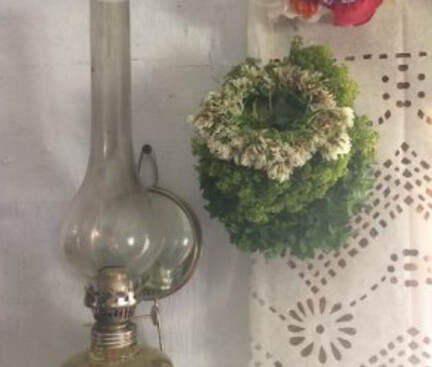 Wreathes of Lady’s Mantle were hung above the entrance to the house, near windows and on the walls above holy pictures, believing that it protected the house against fire, storm and lightning strikes. Wreaths of Lady’s Mantle were also burned on hot coals, incensing sick people as well as ailing animals. Lady’s Mantle can easily be grown in the garden. As a perennial, it does well in shady areas and is quite hardy in cold temperature regions. If you just want to add the yellow-chartreuse flowers to a dry arrangement for your home altar perhaps, they hold up pretty well after hanging the stems upside down in an airy space for a few weeks.
For more on the flowers and plants once essential to the people of Poland available in: Polish Herbs, Flowers and Folk Medicine, Hippocrene Books, Inc. For more images on the making of Corpus Christi wreaths: muzeumrolnictwa.pl/aktualnosci/archiwum/rok-2018/wianki-w-oktawe-bozego-ciala TODAY, ALL ACROSS OUR NATION, MEN AND WOMAN WILL STEP UP TO PODIUMS LIKE THIS AND TRY TO DELIVER TO THOSE ASSEMBLED BEFORE THEM, WORDS THAT ADEQUATELY EXPRESS OUR GRATITUDE TO AND UNDERSTANDING OF THOSE WHO HAVE DIED IN THE NAME OF OUR NATION. AND ALL OF US WILL FAIL, NO MATTER HOW WELL INTENDED, HOW HEARTFELT OUR WORDS AND FEELINGS, FOR THE WORDS OF ONE HUMAN BEING CAN NEVER EXPRESS WHAT THOSE WHO SACRIFICED HAVE DONE. BUT COLLECTIVELY, YOU AND I, JUST BY BEING HERE, ARE HONORING THEM AS BEST WE CAN. Ronald Halicki in Vietnam who wrote this tribute honoring his troop and all those who have fallen.
AMERICAN SERVICE MEN AND WOMEN HAVE ALWAYS PLACED THEIR BODIES BETWEEN AN ENEMY AND THEIR HOMES -- HOMES THAT WERE USUALLY MANY THOUSANDS OF MILES AND TIME ZONES AWAY, IN LANDS WITH DIFFERENT NAMES, LANGUAGES, FACES, CUSTOMS AND ENVIRONMENTS. AND WHEN SITUATIONS AROUND THEM DICTATED WHAT NEEDED TO BE DONE, THEY DID WHAT THOSE WHO SERVE HAVE ALWAYS DONE. THEY MUSTERED THEIR STRENGTH BEYOND THEIR FEARS AND MOVED FORWARD, WEARING THE COLORS OF OUR NATION AND IN SO DOING, THEY PROTECTED AND LIBERATED MILLIONS OF PEOPLE ALL OVER THE WORLD. A SOLDIER'S LEGACY IS OF THE HIGHEST ORDER THAT ANY HUMAN CAN ACHIEVE, SACRIFICING ALL THAT THEY ARE, ALL THAT THEY MAY EVER HAVE BEEN, SO THAT OTHERS CAN BE FREE.THOSE THAT WE HONOR TODAY HAVE DONE ALL THAT AND, IN ADDITION, THROUGH THE CRUEL HAND OF FATE, MANY DIED DOING SO. THEY PLACED THEMSELVES AS THE FIRST LINE OF DEFENSE. YOU AND I RIGHT NOW ARE STANDING IN THE HOME TOWN OF MANY OF THOSE WHO HAVE SERVED AND DIED, A HOME TOWN THAT THEY WERE NEVER FAR AWAY FROM IN THEIR HEARTS, WHEREVER THEY WERE. SERVICE MEN AND WOMEN ALL WANT TO GET BACK TO FAMILY…TO MOTHERS, FATHERS, SISTERS, BROTHERS, LOVED ONES, DAYS FILLED WITH SUNSHINE...ALL THE THINGS THAT WE HAVE RIGHT NOW IN THIS MOMENT...TO JUST REMINISCE ABOUT SCHOOL DAYS WITH OLD FRIENDS, FUSS OVER POLITICS, SHARE THE BURDEN OF SNOW STORMS, CREATE NEW STORIES, PUT THINGS AWAY IN DRAWERS, HEAR SONGS ON THE RADIO, PARTAKE IN THE LARGE AND SMALL THINGS OF OUR LIVES. THEY WANTED TO GET HOME TO BE ABLE TO STAND WHERE YOU ARE RIGHT NOW, TO SHARE A SMILE FROM A FRIEND OR STRANGER, TO PARTAKE IN A COMMUNITY BY DOING FOR OTHERS, IN OUR HOSPITALS, SCHOOLS OR FIRE DEPARTMENTS. I DO NOT BELIEVE THAT THEY CARE TO BE SINGLED OUT FOR RECOGNITION, BUT THEY DO WANT TO BE REMEMBERED COLLECTIVELY FOR THE HEROICS THEY WITNESSED BY THEIR FELLOW MATES FAR MORE THAN THEIR OWN SACRIFICES. I BELIEVE THAT THEY WANT US TO FIND ALL THOSE WHO ARE STILL MISSING AND BRING THEM HOME. BUT WHETHER OR NOT THEIR BODIES, KNOWN OR UNKNOWN, ARE ON OUR SOIL OR LYING STILL IN SOME FOREIGN LAND...ITALY, BELGIUM, KOREA... WE CAN BRING THEM HOME ONCE AGAIN, IN THIS MOMENT, BY JUST REMEMBERING WHAT THEY ALL HAVE SACRIFICED. I USED TO THINK THAT FREEDOM WAS ONLY "FREE" FOR THOSE WHO NEVER SERVED. AFTER ALL, WE ARE THE LUCKY 99%. IT'S THE SERVICE MEN AND WOMEN, THE 1 PERCENT, THE 3 MILLION, WHO PROTECT THE 300 MILLION REST OF US. BUT I WAS WRONG. WE HERE AT HOME HAVE SHARED THE SACRIFICES OF THOSE WE HONOR IN A MILLION WAYS TOO NUMEROUS TO MENTION, BUT REALIZE THAT FROM THE TIME A SOLDIER LEAVES HOME UNTIL THE TIME HE RETURNS, HIS OR HER THOUGHTS ARE OF YOU, AS THEY AWAIT A SIMPLE LETTER OR KNOWING THAT THEY ARE IN YOUR SILENT PRAYERS, THE PRAYERS THAT THEY KNOW WILL PROTECT THEM. BY STANDING HERE TOGETHER WE DO HONOR THEM, OUR FALLEN, IN THEIR COLLECTIVENESS. FOR TODAY, BY THIS REMEMBRANCE, BY THE READING OF THEIR NAMES, THEY ARE KNOWN TO US ONCE MORE THROUGH THEIR SINGULAR ETERNAL SILENCE. ENJOY THIS DAY AND EACH OTHER. IT IS WHAT THEIR VERY LIVES HAVE GIVEN YOU. TODAY, IN THIS PUBLIC FORUM, FOR THE FIRST TIME IN MY LIFE, I WOULD LIKE TO PERSONALLY AND FORMALLY HONOR THE FALLEN OF MY UNIT IN VIETNAM. THEY WERE JUST A SMALL SQUADRON, BUT THESE YOUNG MEN FOUGHT AS IF THEY WERE A DIVISION. TO THE 293 TROOPERS OF THE 1ST SQUADRON, 4TH CAVALRY, 1ST INFANTRY DIVISION, I SALUTE YOU AND BY REMEMBERING YOU, INTRODUCE YOU TO THE PEOPLE OF FORESTVILLE, N.Y. AND I REPEAT OUR MOTTO: NO MISSION TOO DIFFICULT. NO SACRIFICE TOO GREAT. DUTY FIRST. PREPARED AND LOYAL. It’s always such a treat to walk your garden after a long, hash winter and discover that a plant has survived and is flowering. Hello there! You made it! So happy to see you! I was genuinely pleased to see the tiny rose- colored flower of lungwort. Lungwort in my garden in early May. Lungwort’s scientific name, Pulmonaria officinalis, comes from the Latin pulmo which means lung, hence the common name: lungwort. It was the name used by herbalists in medieval times who believed that the plant was effective in the treatment of lung diseases. In 1649, the noted English herbalist Nicholas Culpeper, wrote that it was good for coughs and shortness of breath – all lung related illnesses. The plant was also known in Poland and utilized in much the same way: 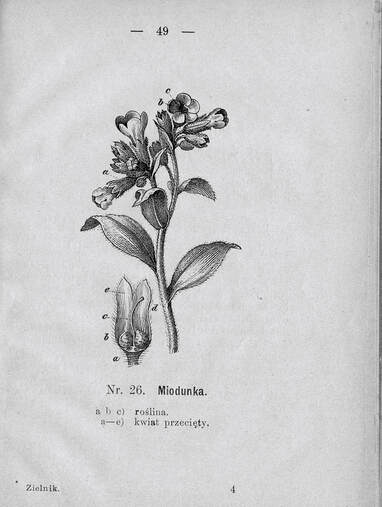 "This is a plant found throughout all of Poland in woods and thickets that are somewhat damp and one of the first harbingers of spring, flowering as soon as March or April and recognized by its flower which begins rose-colored and later bluish-violet" says Sebastian Kneipp in his Zielnik czyli Atlas roślin leczniczych Domowa Apteka (Herbal or Atlas of healing plants for Home Pharmacy). He recommended using the large leaves that develop after it flowers to make a tea for those suffering lung and throat ailments, laryngitis, and hoarseness. The flower of lungwort does change color as the flower ages. Opening pink, it changes to a rose-violet color over time and at maturity will be blue due to a changing pH value within the flower. It's Polish name miodunka, meaning honey, also indicates that it was a source of early flowering source of nectar for bees. Illustration from Kneipp's Zielnik (Herbal of Healing Plants for Home Pharmacy) For more on plants and flowers and Polish gardens: POLISH HERBS, FLOWERS AND FOLK MEDICINE. Hippocrene Books, Inc. Driving along a country road last August, I caught sight of a patch of bright yellow flowers out of the corner of my eye. I pulled over and turned the car around to take a better look. I had to climb through a ditch to get close and realized I was looking at a beautiful stand of the Jerusalem artichoke flower. The sight of them on that sunny Saturday morning was uplifting. 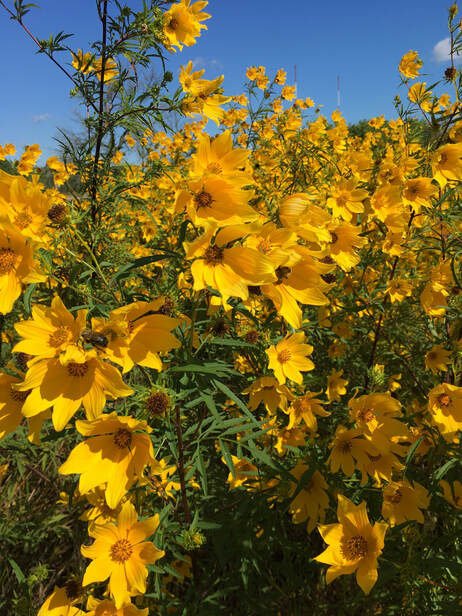 Jerusalem artichoke is not an artichoke at all but belongs to the sunflower family (hence it’s Polish name, słonecznik which means sunflower) but with a flower that is much smaller. It does, however, have that tall stature in its lineage along with many lush green leaves along it’s stem. Besides the flower which gladdens the eye and heart, the plant produces roundish and oblong tubers on the underground shoots that are edible as a root vegetable. The plant was at one time plentiful in Polish gardens, the tubers a food staple until it was replaced by the potato as a common dish on the tables of the wealthy and poor alike. Polish gardeners advised: "Once planted, they always persist, planted one elbow length from one another... Tubers for winter left in the ground will become a great delicacy in the spring." Flower of Jerusalem artichoke. Author photo. Wikipedia photo.
Historians say that Jerusalem artichoke first appeared in France in 1607, supposedly by way of Canada, and then appeared in Poland in the 17th century. Recipes for its use can be found in the first Polish cookbook titled Compendium Feculorum published in 1682. When it stopped being food for the table, the tubers were used as fodder to feed the barnyard animals. Why hadn’t I planted it in my garden? It attracts birds. It’s hardy in winter climates. It tolerates damp places fairly well, is ideal for the back of a perennial garden and apparently a prolific grower and spreader. It only downside seems to be that it can become invasive. This latter fact would be a feat, indeed, in the clay soil of my garden. But if it can grow along roadway ditches and neglected empty fields maybe it has a fighting chance. Another plus is that it can give continuous bloom from August to November when my garden is really waning. I’m ordering the tubers for this year's “something new” to try in the garden. Common Name: Artichoke, Jerusalem Species: Helianthus tuberosus Polish name: Słonecznik bulwiasty Happy National Gardening Day! For more on plants and herbs in Polish gardens: Polish Herbs, Flowers and Folk Medicine, Hippocrene Books, Inc. |
Categories
All
One of the biggest moments in my life was being able to sign for my very own library card. When I'm not reading, researching and writing I'm riding my bike, sewing or gardening. I love flea markets, folk art, and traveling to Poland.
Archives
July 2024
|

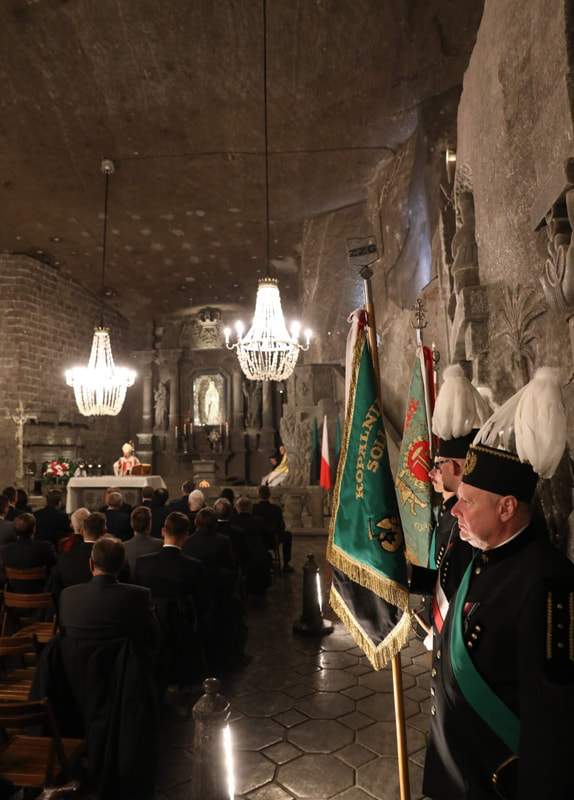
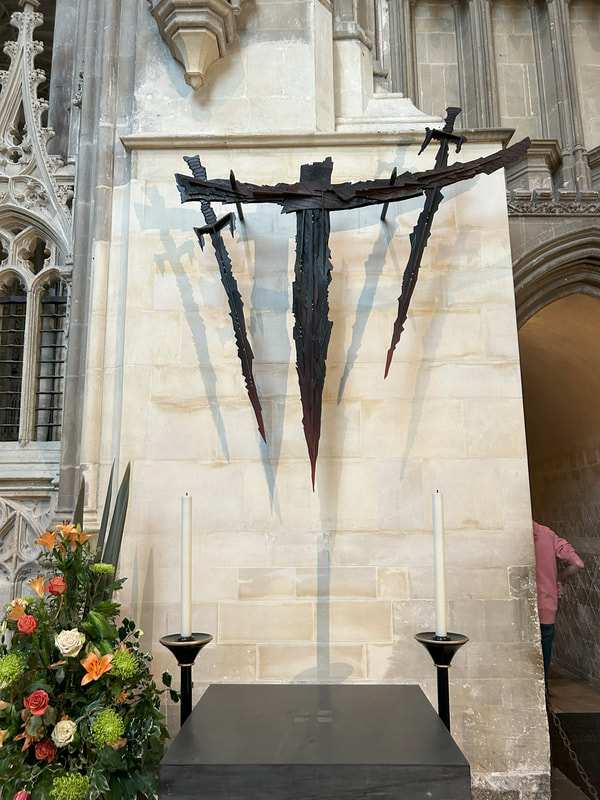
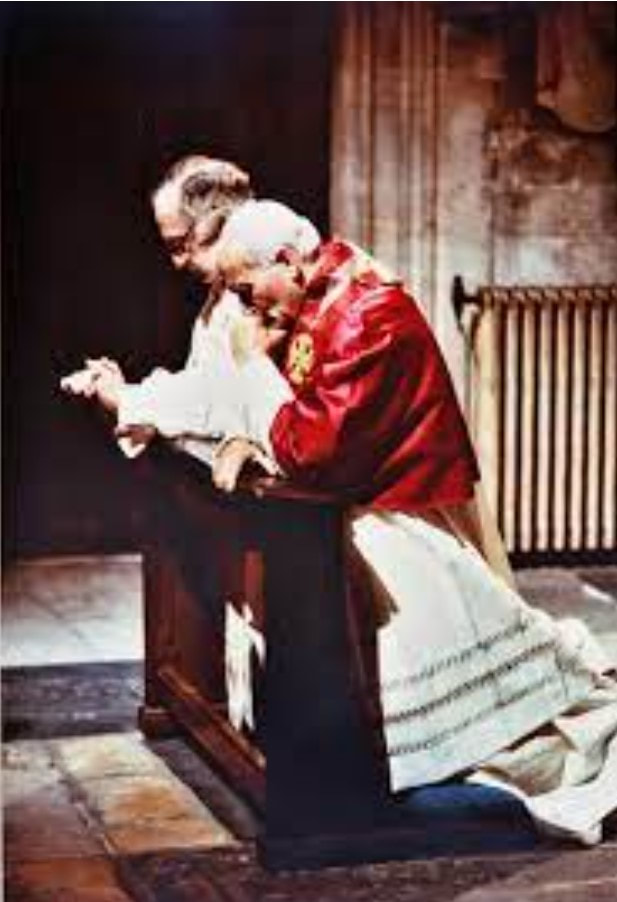
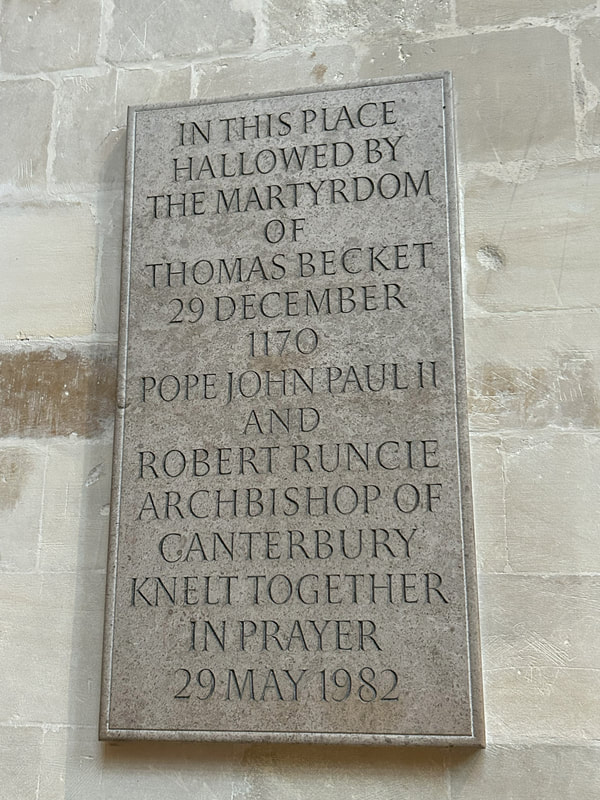
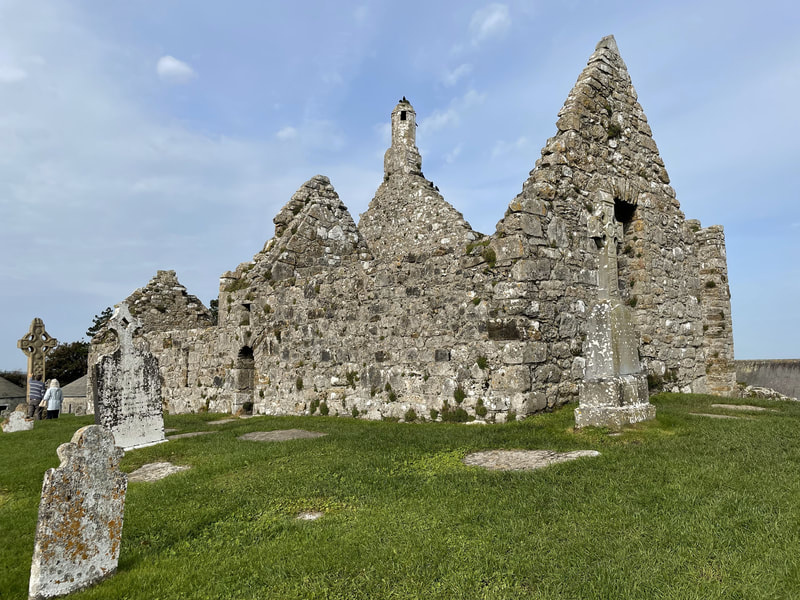
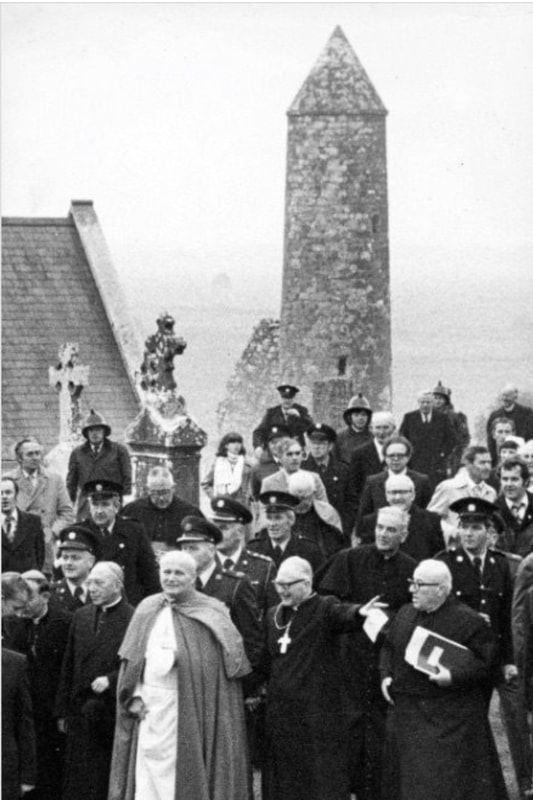
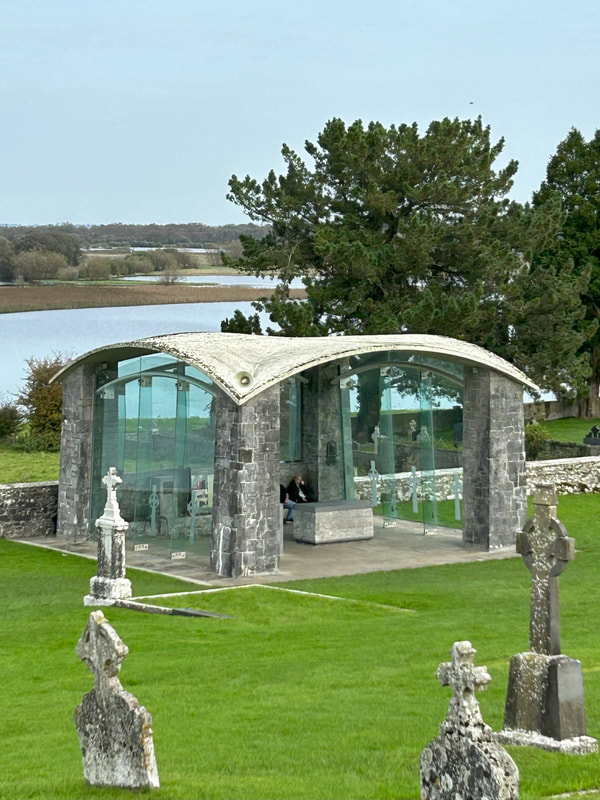



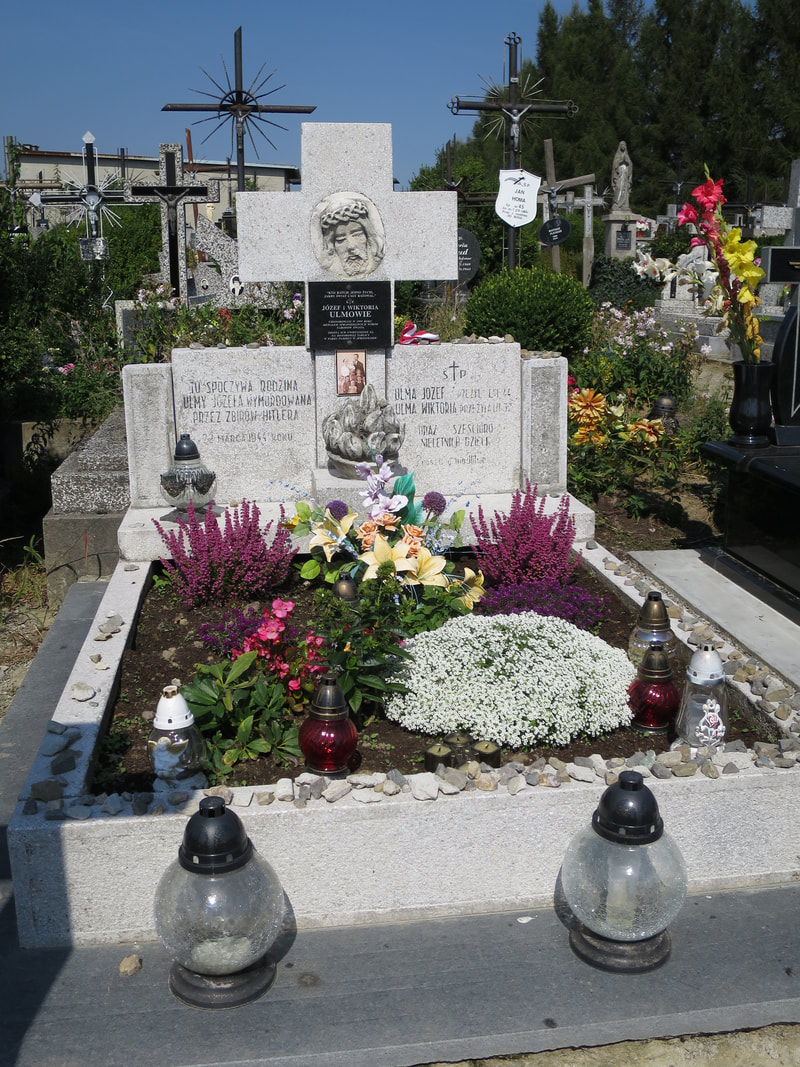
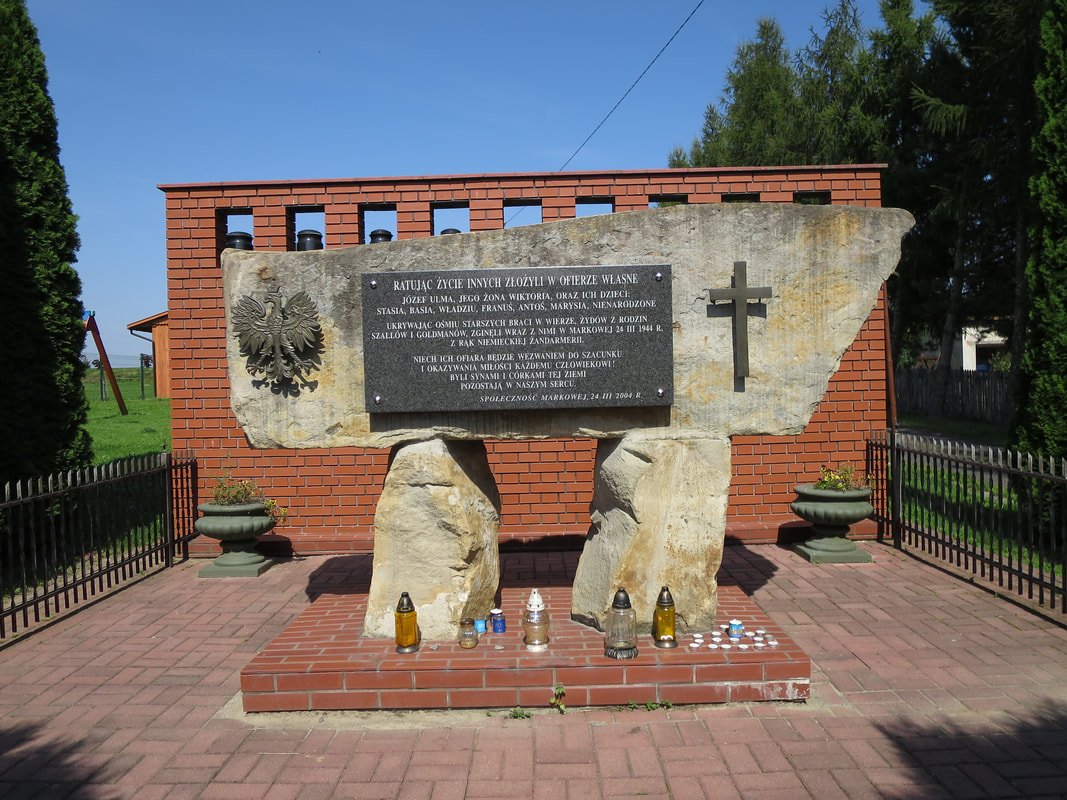
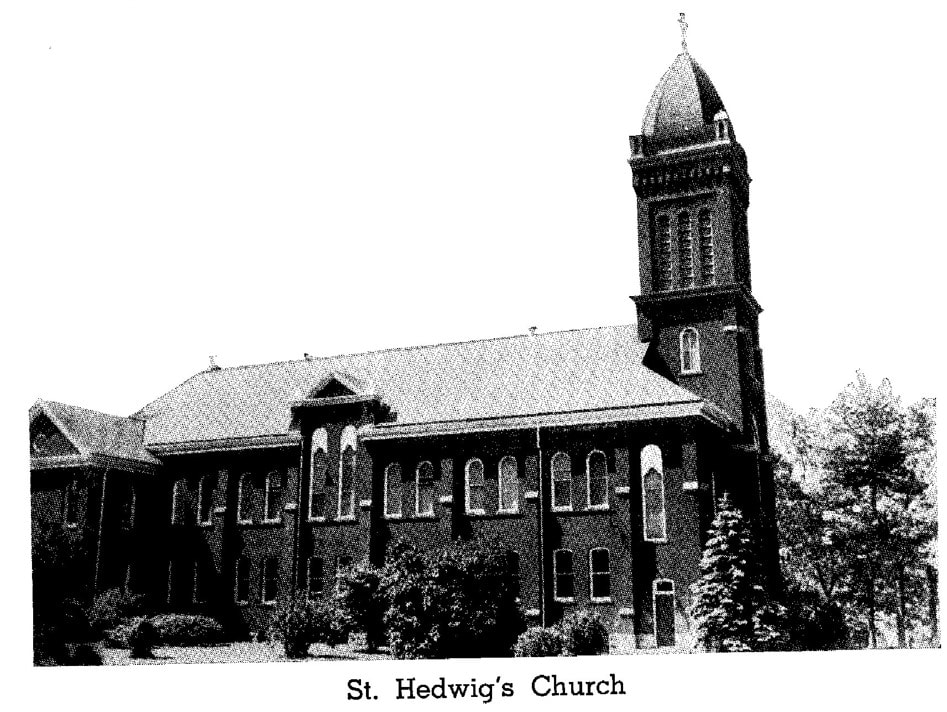
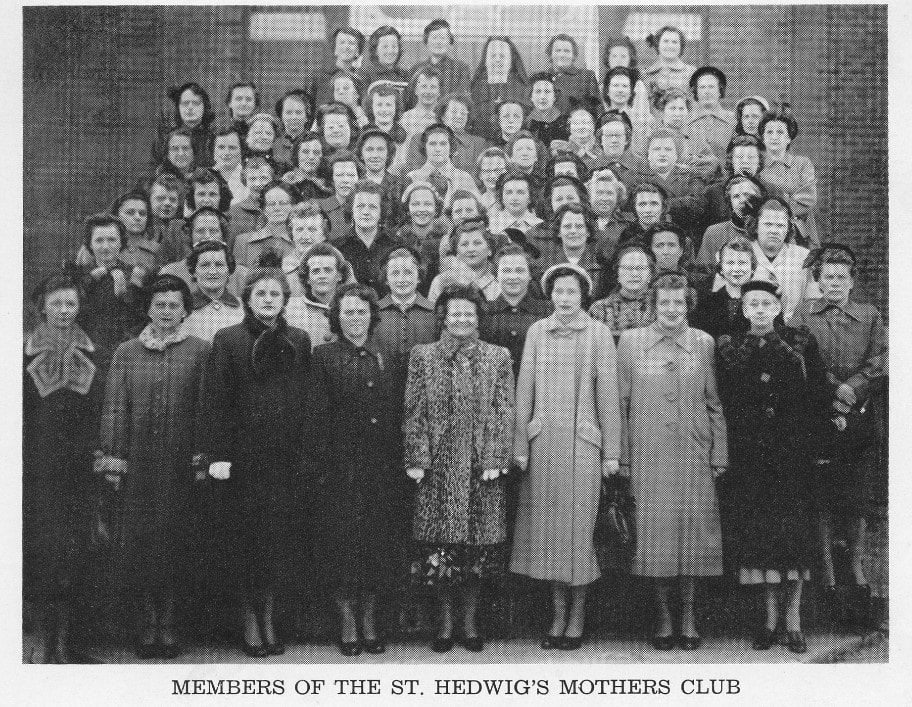
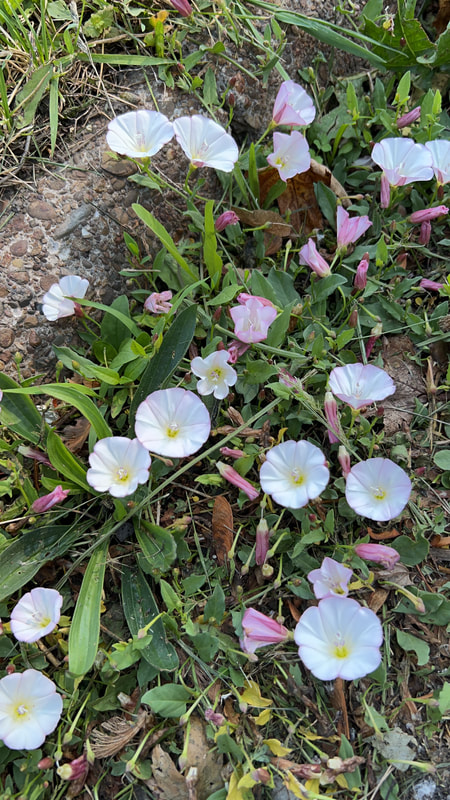
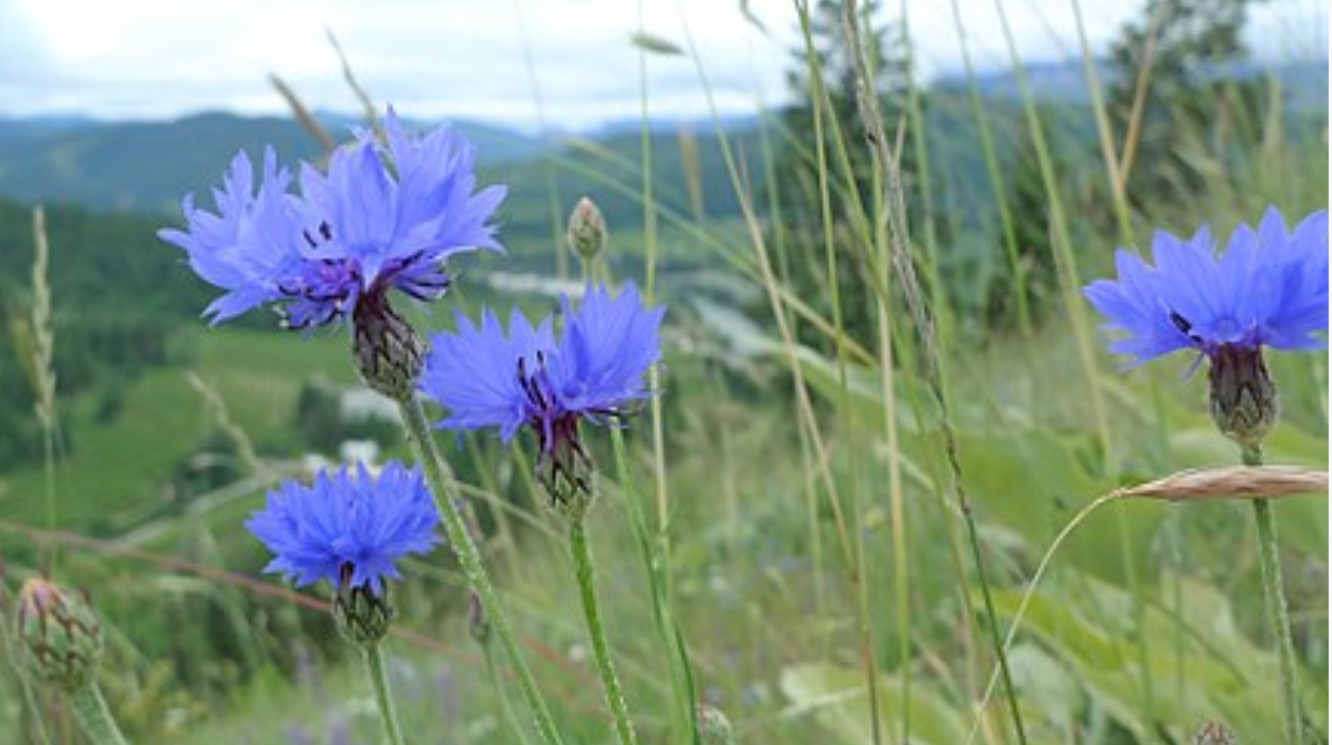
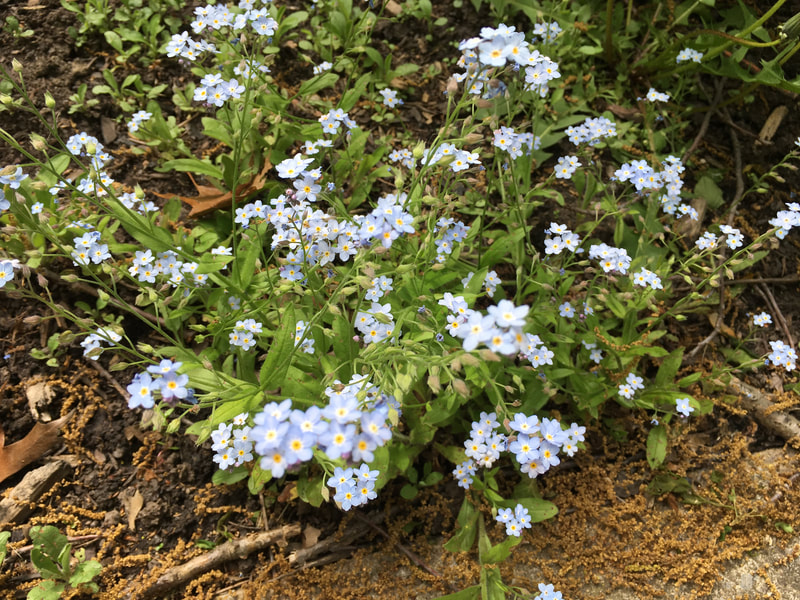
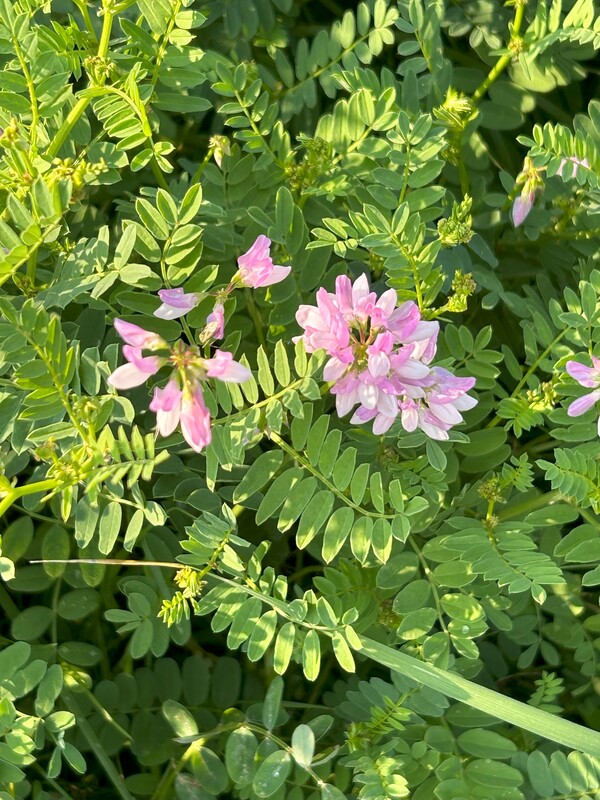
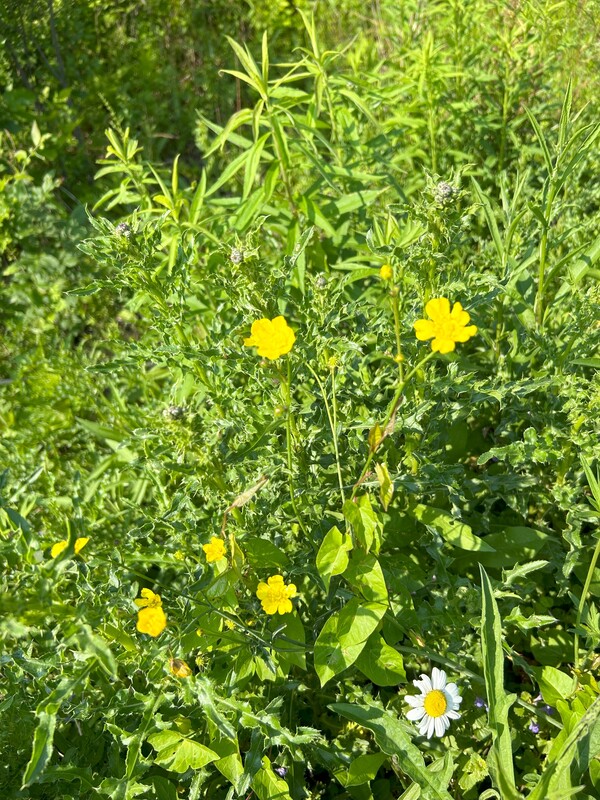
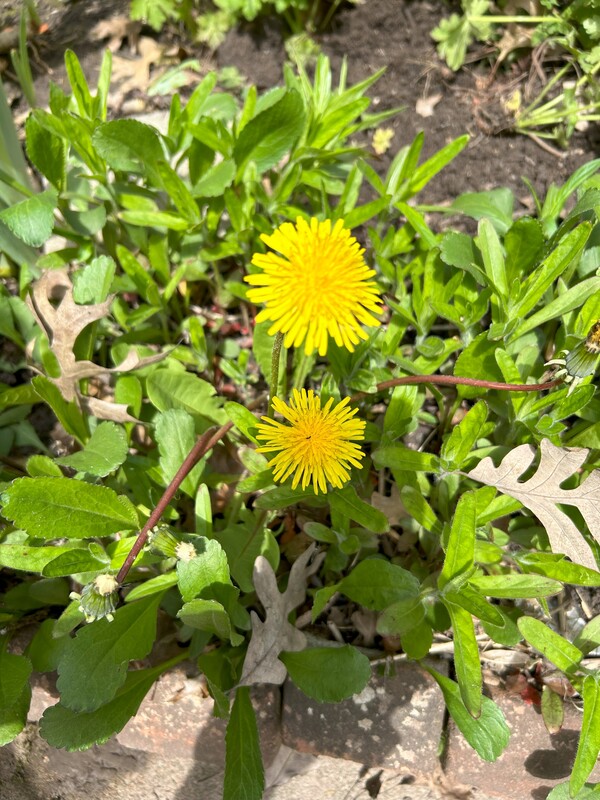
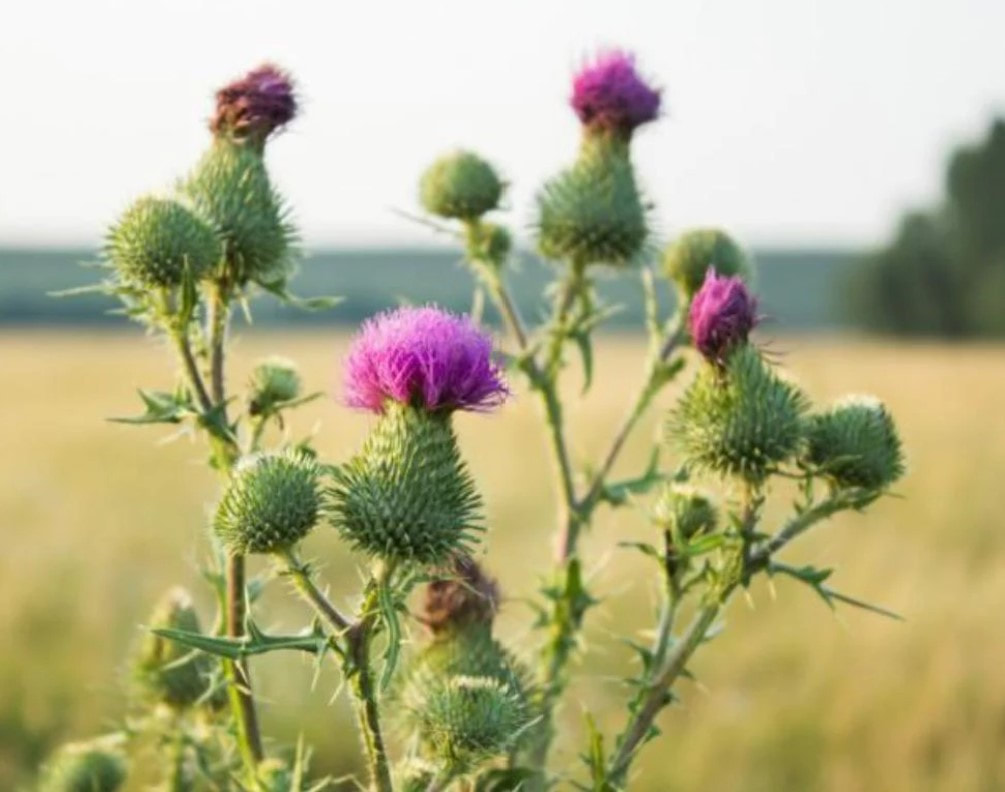
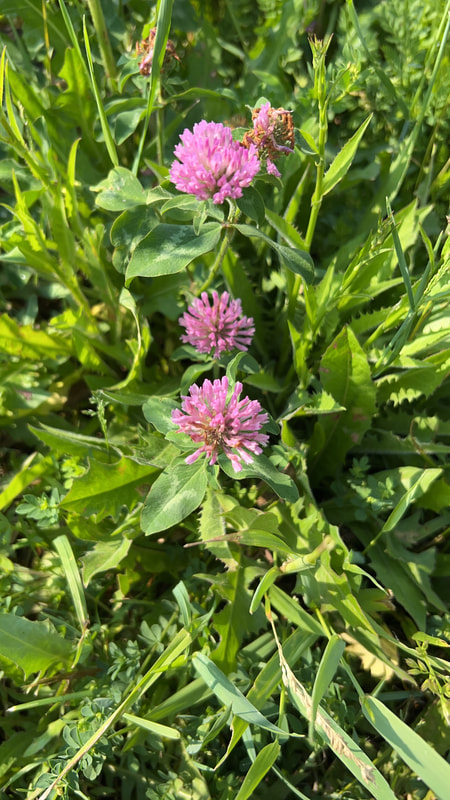
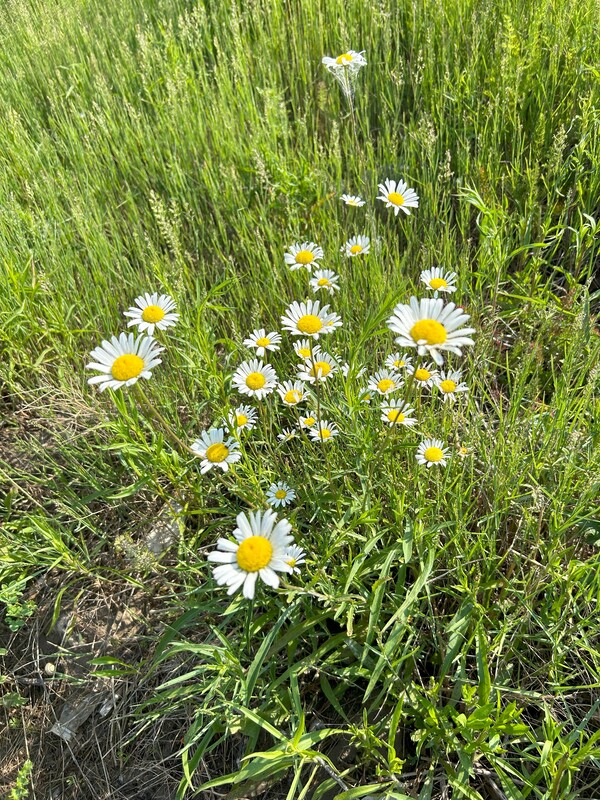
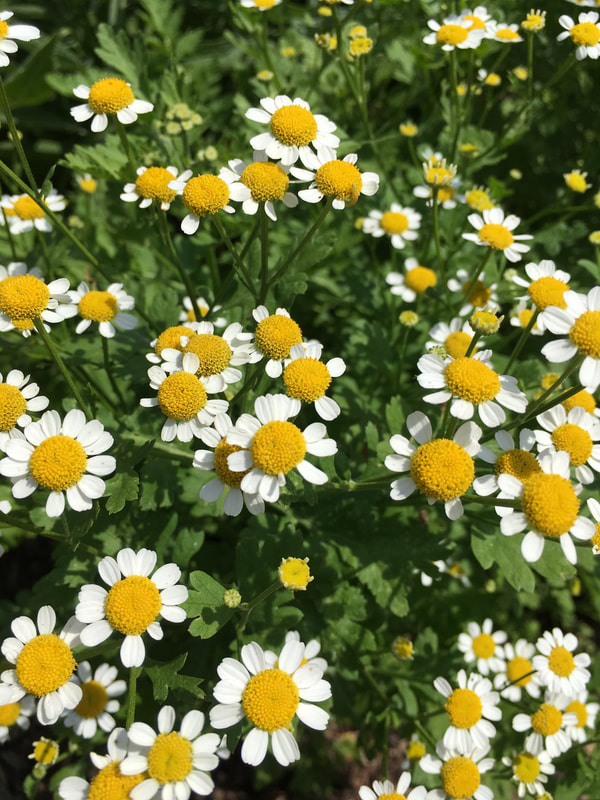
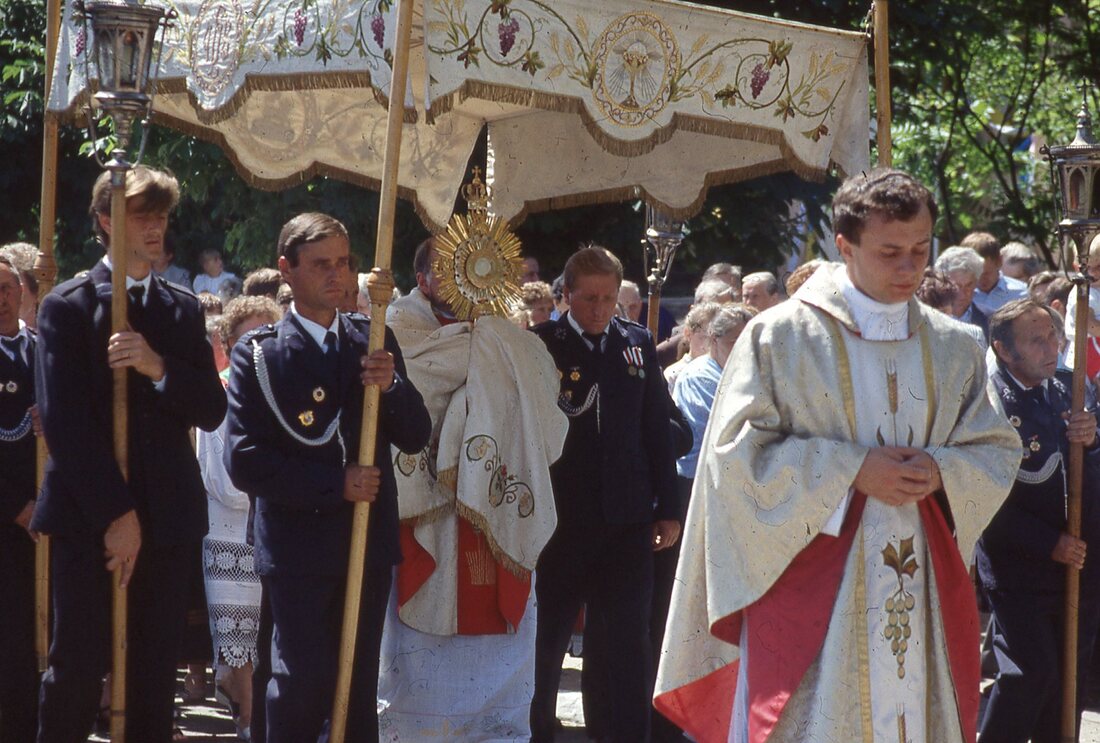
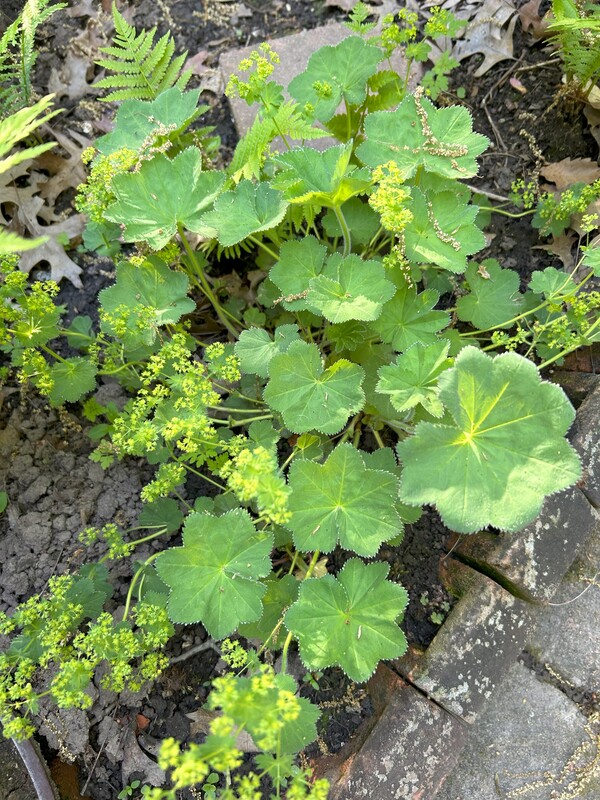
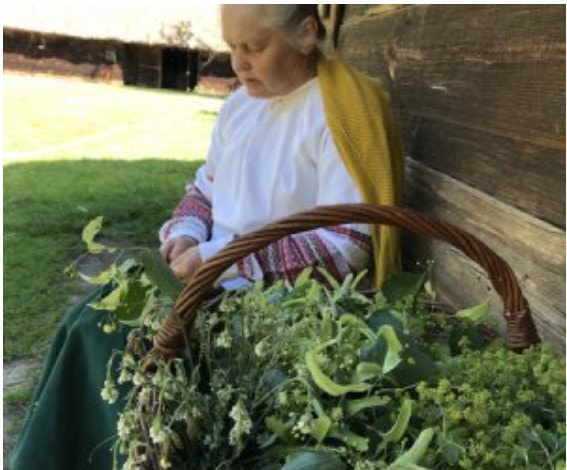
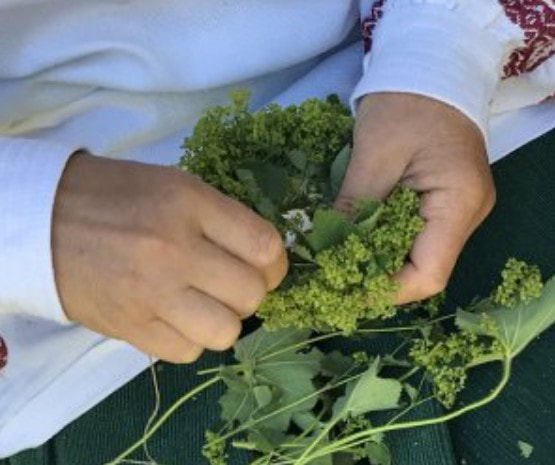
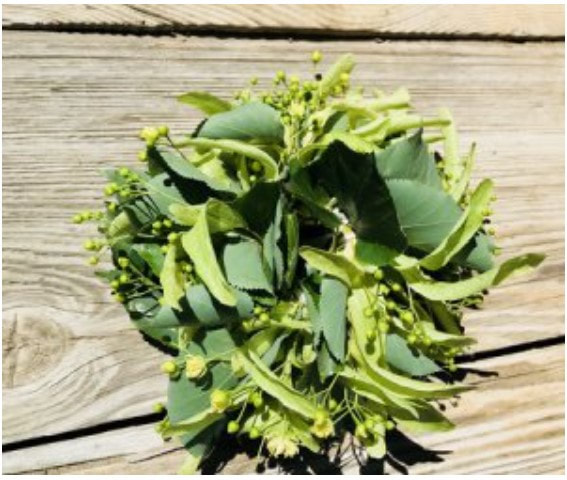

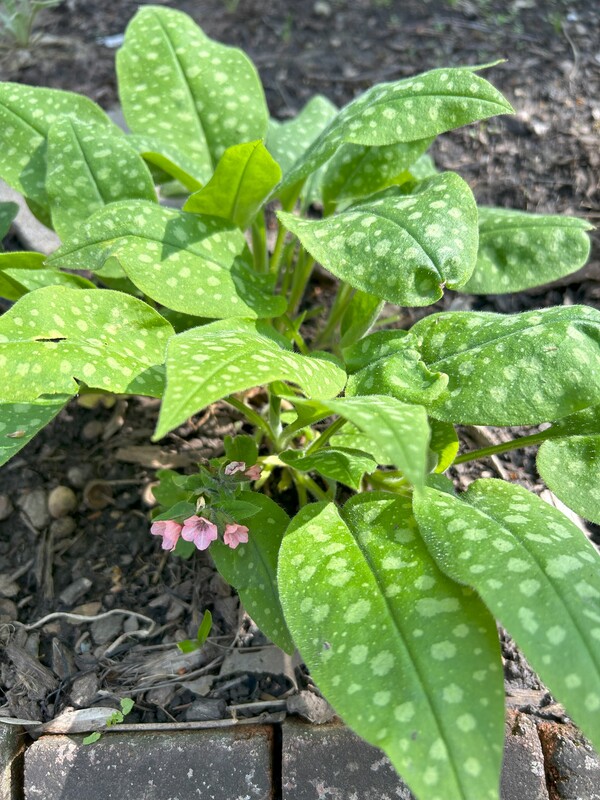
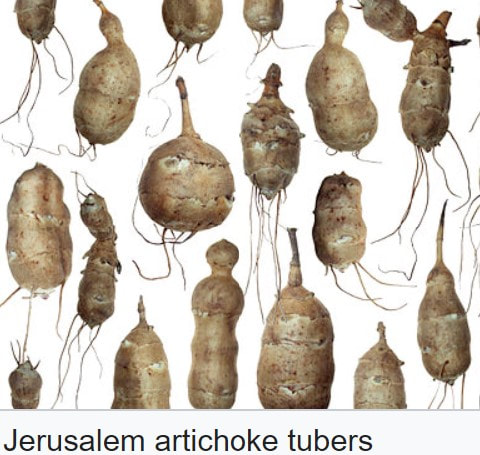
 RSS Feed
RSS Feed